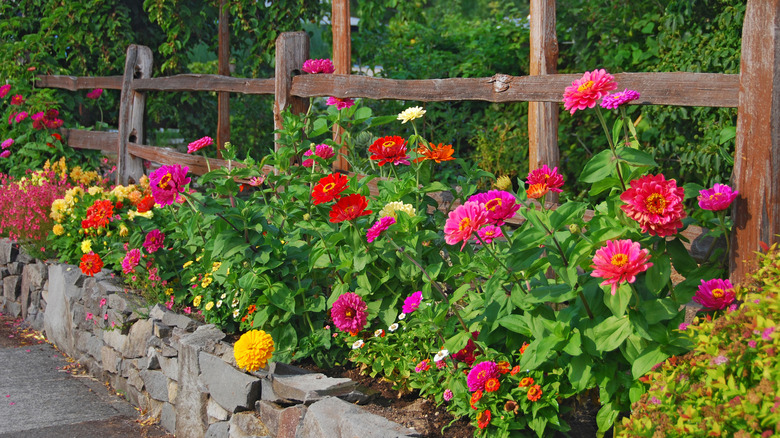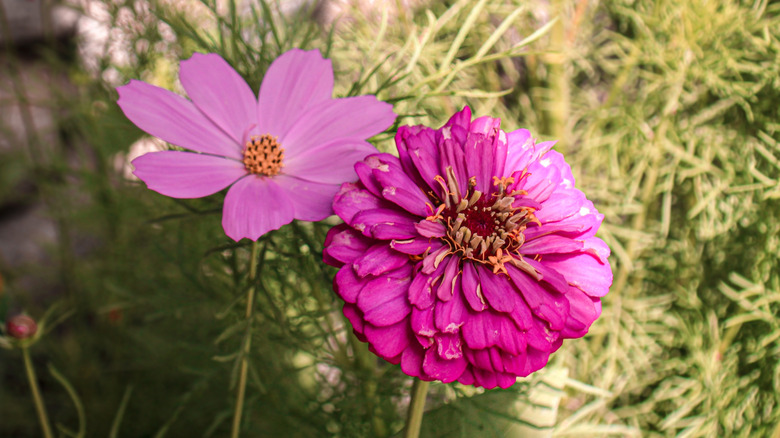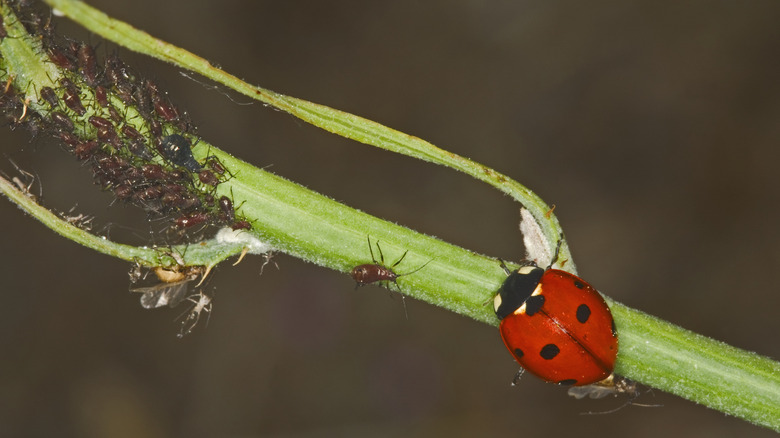Mistakes Everyone Makes When Companion Planting With Zinnias
If you're looking for long-lasting, colorful blooms, you can't go wrong with zinnias (Zinnia elegans). They come in a wide range of heights and colors, and they attract birds, bees, and other pollinators. But if you want to get the most out of these cut flowers, it's essential to learn how companion planting can benefit them. When picking companion plants, there's a lot to consider. The soil, sun, and water conditions that the other plants like will need to align with the conditions zinnias prefer. In this case, you will want to look for plants that love full sun and fertile, well-drained soil that can withstand dry conditions. However, there are two other important things to consider to get the best results: bloom time and zinnia's most common pests.
Companion planting has plenty of practical applications. While distracting or repelling pests is important, in a flower garden, you also want to consider aesthetics. After all, a big reason you've got a zinnia garden at all is because you want it to be pretty — looks matter! A part of keeping them looking their best is ensuring pests don't get to them. Luckily, these two goals can go hand-in-hand, and there are plenty of plants that will help with both.
Not considering bloom time
Bloom times will always vary depending on where you live, but generally, zinnias bloom from summer through fall. So, unless you want a dull flower bed in the spring, it's important to think about when your companion plants will bloom. Look for flowers that bloom earlier in the season to add interest before zinnias get into full swing. For plants that bloom at the same time as zinnias, look for complementary colors and shapes.
Cosmos (Cosmos bipinnatus) is very commonly planted with zinnias. They share similar wants, needs, and bloom at the same time. And, importantly, cosmos are pretty! Learn how to grow cosmos so they can complement your zinnias this summer season. However, to ensure you have plenty of color earlier in the year, consider planting calendula (Calendula officinalis), which blooms from spring into summer. This will add a little extra color to your garden while you wait for the zinnias to come into their own. And there are plenty of other fast-growing spring flowers to create a colorful garden to choose from!
Not using plants that address pest problems
When it comes to companion plantings, it's not all about aesthetics, but many pretty plants also work on a more practical level. Zinnia can be prone to problems with Japanese beetles, aphids, and mites, so finding companion plants that can help address these problems is key. For instance, calendula works on two fronts. Not only do they add color to the garden while you're waiting for your zinnias to bloom, but they also attract hoverflies and ladybugs to eat those dreaded garden pests.
Marigolds (Tagetes) can also help with pests. They bloom all summer, and repel whiteflies and nematodes. Additionally, Japanese beetles tend to be attracted to these plants and may help lure them away from your prized zinnias. When using marigolds as a companion plant, there is one mistake to avoid: planting them too close to other plants. They may overcrowd smaller seedlings or steal valuable water and nutrients. However, their easygoing nature makes them a good choice for zinnia, and their wide range of yellow, orange, and red colors gives you plenty of options to pair with your zinnias.
Nasturtium (Tropaeolum majus) will also make a beautiful and useful addition to your zinnia garden. Not only does their spreading habit make them useful as a living groundcover, but they also attract aphids. Planting nasturtium will give those tiny critters something other than your zinnias to feast on.


